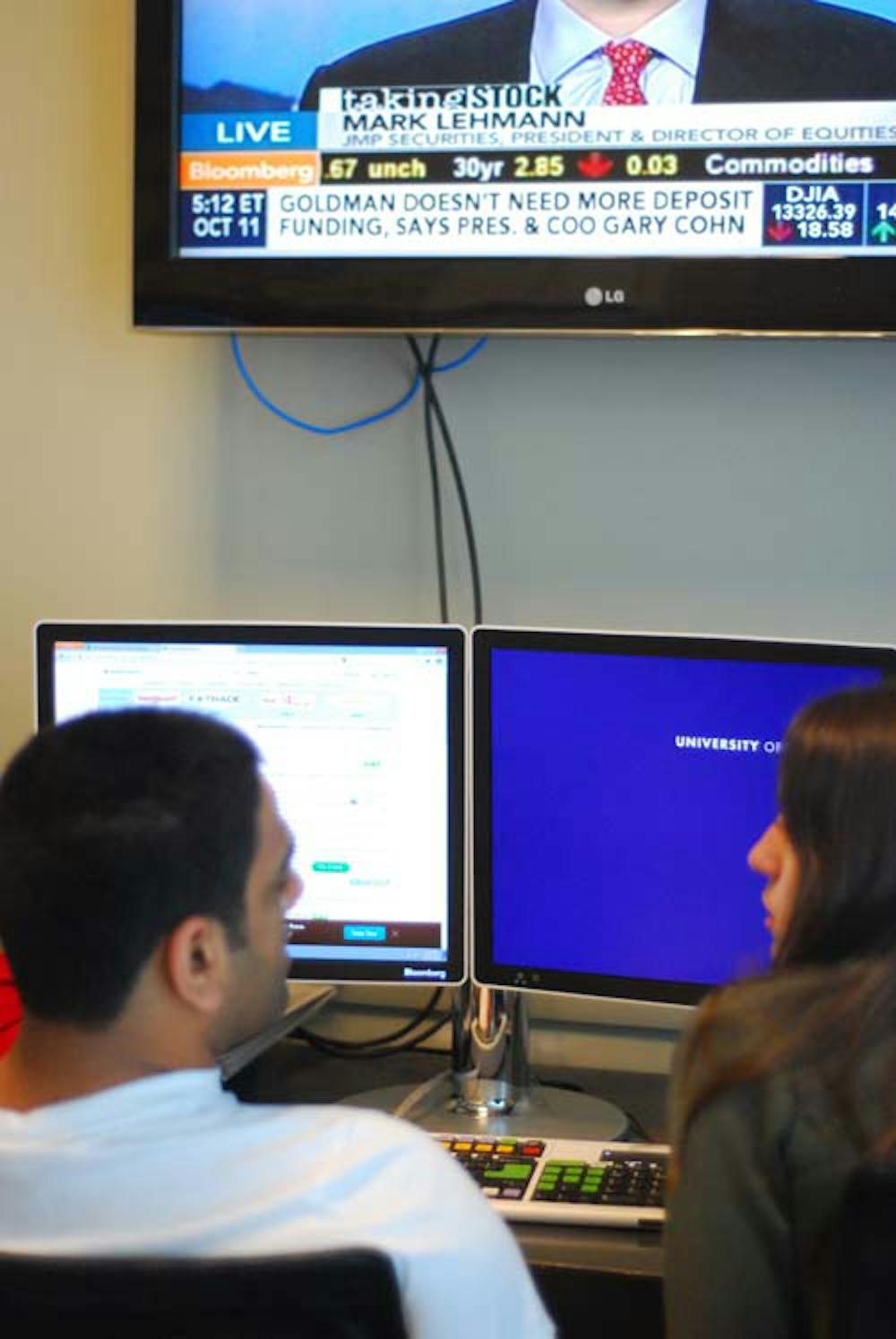The University of Portland Investment Association gives students the chance to work in the stock market
MBA student Gaurav Malik (left) and MSF student Mariia Guk (right) use programs to help track stocks in the Bloomberg Room as part of the UPIA. Students are given $147,000 to invest. (Jackie Jeffers | THE BEACON)
By Kate Stringer, Staff Writer stringer14@up.edu
What would you do with $147,000?
Students in UP's Investment Association (UPIA) ask themselves this question every day. This student-run club brings the world of stock and investment to students of all majors and ranges of experience through the use of UP's Bloomberg Trading Room and real world money.
UPIA was initially created by current UPIA advisor and professor Brian Adams and student Dan Medak in 2003 to manage the Favro student investment fund, a $50,000 donation from UP alumnus Frank Favro, who died in 2009, and his wife Priscilla. From there, UPIA became a platform for students to research and experiment in the stock market without risking personal finances.
Current UPIA Treasurer Ian McCroy, a junior, joined the club as a freshman because of his interest in finance and appreciation for student responsibility in investment decisions.
"We have real money to invest and together we make decisions [about stocks]," McCroy said. "Brian Adams looks over it, but ultimately we pick the stocks."
Through returns on investment, an average return of 7 percent over a year, and additional donations from the Favros, the fund has grown over the past nine years to $147,309.85 as of Oct. 16, according to senior UPIA President Kunal Madan. However, a portion of returns on investment go towards philanthropies as well as the Favro scholarship, Adams said.
Madan credits the club in helping him deepen his understanding of the stock market.
"When I came in as a freshman I knew somewhat about stocks but I didn't know how to analyze stocks or to know what a good investment is," Madan said. "By being involved in the club, I've learned how to pick good stock based on data gathered."
In addition to allowing student investment, the UPIA is also set up to educate its members on the stock market. Madan says the bi-weekly club meetings discuss sectors of the stock market, why companies have increases or decreases, market overviews and stock pitches.
"I have a better idea of how everything works," McCroy said. "There were all these different companies I've never heard of, different companies and different sectors. I like following companies and seeing how [the stocks] move - seeing how the business world works."
Senior UPIA member Colin Donahue appreciates the opportunity the club provides to students who want to learn more about investing.
"We don't study this in school, so anyone has a chance [to learn]," Donahue said.
For some students, joining the UPIA was their first experience with investment.
"A lot of [club members] don't know anything about stocks," Madan said. "We just start at ground zero and work our way up."
The Bloomberg Trading Room in Franz, workroom of the UPIA, can seem like an entirely new world for some. Large computer monitor's line the walls, flashing hundreds of multi-colored numbers and charts. A glass panel of zig-zaging graphs covers the back wall, marked with equations and strange terms.
The Bloomberg terminals are a set of computer systems that provide access to companies' financial information that aren't listed on the internet. This information includes analysts' reports, company research, and real-time stock quotes. Trades are also made through Bloomberg terminals.
UP has nine Bloomberg terminals, the largest trading room on the west coast. The terminals are open for all students to use; Adams says all students who want key card access can receive it from him.
"[UPIA is] open to anybody and everybody," Adams said. "Student's don't get a lot of opportunities to invest. The only way to get experience is to use money and learn from their failures. The only way students can do that is using real money."
Madan says the UPIA has played a large part in preparing him for his career by combining classroom theory with real-world application.
"I really like this club because it allows me to apply the data from what I learned in all my classes to real life money," Madan said. "I'm pretty much trading off the knowledge I learned and it gives me real life experience which is really valuable to employers."
Whether you're a business student or a nursing student, you're encouraged to come learn what to do with 147,000 dollars.
"Even if you know nothing, come, watch and learn," said Donahue.
(Jackie Jeffers | THE BEACON)
(Jackie Jeffers | THE BEACON)








